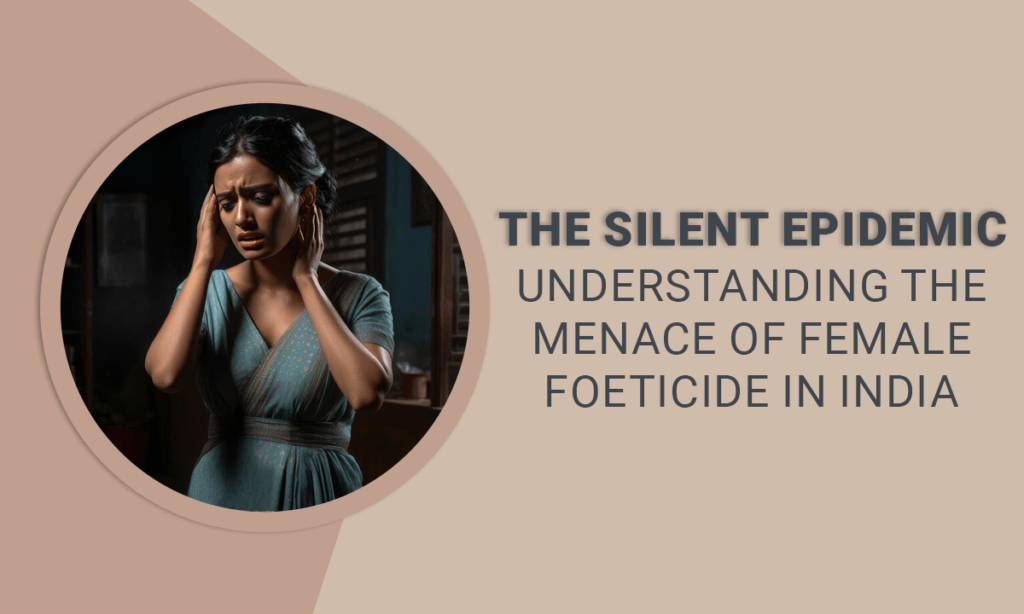Female foeticide refers to the illegal abortion of a female foetus. It also includes the process of determining the gender of the foetus and undergoing abortion if it is a girl. It is nothing but a cold-blooded murder. No one has the right to take a life.
Female foeticide is a form of gender discrimination that demonstrates the widespread inequality that exists between men and women. The introduction of modern reproductive and sex selection techniques has provided ample opportunity for female foeticide all over the world. It is not inappropriate to state that female foeticide occurs with our society’s full approval. Sex selection violates the Constitution and the dignity of women.
Female foeticide is a persistent social issue that has hampered the nation’s progress for a long time. But what is so bad about a girl child, particularly in Northern parts of India? Simply put, the socioeconomic system in such places has been designed to benefit men, and people consider the birth of a girl child as a poor investment for the future.
The causes of female foeticide are deeply embedded in India’s social fabric. The bias against women in India has cultural, economic, and religious roots. People’s mindsets must be changed in order for them to be free of the dictatorship of unhealthy and inhuman traditions. People are constantly subjected to social pressure, which drives them to commit such acts. There are several reasons cited for that:
- The increased availability of advanced technologies, particularly ultrasonography (USG), has been the single most important factor contributing to a decrease in sex ratios and an increase in female foeticide.
- Male children are given preferential treatment in Indian society. There is no denying that there is a strong bias in favour of male children in India. This preference has resulted from a variety of factors. Male children are preferred because they have a higher earning potential due to income disparities, especially in agrarian economies like India. It is also believed that male children carry the legacy of the family forward, and only male children are permitted to perform religious rites at the time of the cremation of the parents. Male children are said to provide support in old age and to be the recipients of a family’s inheritance. Girls are often considered an economic burden because of the dowry system. They typically become members of their husband’s family after marriage and no longer have responsibility for their parents in illness or old age.
- The prospect of having to pay a dowry to the future bridegroom of a daughter is yet another factor for female foeticide. Dowry is a malignant practice that is widely spread in India. As a result, daughters are viewed as an economic liability, and diagnostic teams take advantage of this anti-female bias. The dowry system is more rigid in northern India, which may contribute to the lower child-sex ratio. The threat of declining sex proportion is one of the most serious threats to modern human progress.
- Even today, more than a quarter of the Indian population is illiterate. Lack of education among Indians has proven to be detrimental to their social and psychological front.
From the past to the present, enormous efforts have been made by social thinkers, reformers, and philanthropists to put an end to the practice of killing female children, whether through female infanticide or female foeticide. Despite their efforts, the practice has persisted, posing a serious threat to humanity by creating an unsustainable imbalance in the country’s male and female populations. To make matters worse, the country’s laws are insufficient and ineffective in combating the threat posed by female foeticide.
Legality of Abortion in India
Abortion is legal in India, but sex-selective abortions, or abortions based solely on the gender of the foetus are prohibited. Legal abortions are only performed at the doctor’s discretion. The woman has no right to choose whether or not she wants to have an abortion. In the 1990s, when ultrasound technology became widely available to upper-class and upper-caste society members, female foeticide based on sex-determination testing increased dramatically in India. The Indian government then passed the Pre-Conception and Pre-Natal Diagnostic Techniques Act (1994), which made determining a foetus’s gender illegal unless it was absolutely necessary for medical reasons.
Social impact of a skewed sex ratio
According to studies, countries with unequal sex ratios have a more violent culture. Men are likely to do more crime in order to gain economic stability. Studies have shown that when there is an enormous surplus of men within countries with a skewed sex ratio (30+ million within India), they are unlikely to obtain stability economically through labour or socially through marriage. However, in some areas where the female-to-male ratio is alarmingly low, men are unable to find suitable brides. As a result, brides are “purchased,” resulting in forced marriages and human trafficking.
Simply prohibiting the use of medical technology for sex selection has not given a solution to female foeticide. Legal measures will continue to be undermined and ineffective in the absence of education and cultural change. However, the link between technology and gendercide is so clear that nations must find the will and means to implement such laws decisively.
People Also Read: Challenges and Innovations: Expanding Access to Ambulance Services in Rural India
